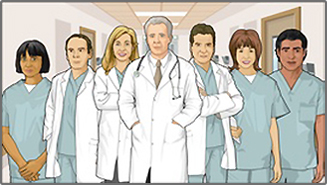Bone pain or tenderness
Bone pain or tenderness is aching or other discomfort in one or more bones.
Considerations
Bone pain is less common than joint pain and muscle pain. The source of bone pain may be clear, such as from a fracture following an accident. Other causes, such as cancer that spreads (metastasizes) to the bone, may be less obvious.
Muscle pain
Muscle aches and pains are common and can involve more than one muscle. Pain due to muscles can also be felt in ligaments, tendons, and fascia. Fas...

Fracture
If more pressure is put on a bone than it can stand, it will split or break. A break of any size is called a fracture. If the broken bone punctures...

Causes
Bone pain can occur with injuries or conditions such as:
- Cancer in the bones (primary malignancy)
- Cancer that has spread to the bones (metastatic malignancy)
- Disruption of blood supply (as in sickle cell anemia)
- Infected bone (osteomyelitis)
Osteomyelitis
Osteomyelitis is a bone infection. It is caused by bacteria or other germs.
 ImageRead Article Now Book Mark Article
ImageRead Article Now Book Mark Article - Injury (trauma)
- Leukemia
- Loss of mineralization (osteoporosis)
Osteoporosis
Osteoporosis is a disease in which bones become fragile and more likely to break (fracture).
 ImageRead Article Now Book Mark Article
ImageRead Article Now Book Mark Article - Overuse
- Toddler fracture (a type of stress fracture that occurs in toddlers)
Home Care
See your health care provider if you have bone pain and do not know why it is occurring.
When to Contact a Medical Professional
Take any bone pain or tenderness very seriously. Contact your provider if you have any unexplained bone pain.
What to Expect at Your Office Visit
Your provider will ask you about your medical history and do a physical exam.
Some questions that may be asked include:
- Where is the pain located?
- How long have you had pain and when did it start?
- Is the pain getting worse?
- Do you have any other symptoms?
You may have the following tests:
- Blood tests (such as CBC, blood differential)
- Bone x-rays, including a bone scan
Bone x-rays
A bone x-ray is an imaging test to look at the bones.
 ImageRead Article Now Book Mark Article
ImageRead Article Now Book Mark Article - CT or MRI scan
CT
A computed tomography (CT) scan is an imaging method that uses x-rays to create pictures of cross-sections of the body. Related tests include:Abdomin...
 ImageRead Article Now Book Mark Article
ImageRead Article Now Book Mark ArticleMRI
A magnetic resonance imaging (MRI) scan is an imaging test that uses powerful magnets and radio waves to create pictures of the body. It does not us...
 ImageRead Article Now Book Mark Article
ImageRead Article Now Book Mark Article - Hormone level tests
- Pituitary and adrenal gland function tests
- Urine tests
Depending on the cause of the pain, your provider may prescribe:
- Antibiotics
- Anti-inflammatory medicines
- Hormones
- Laxatives (if you develop constipation during prolonged bed rest)
- Pain relievers
If pain is related to thinning bones, you may need treatment for osteoporosis.
Reviewed By
Linda J. Vorvick, MD, Clinical Professor Emeritus, Department of Family Medicine, UW Medicine, School of Medicine, University of Washington, Seattle, WA. Also reviewed by David C. Dugdale, MD, Medical Director, Brenda Conaway, Editorial Director, and the A.D.A.M. Editorial team.
Jones RL. Malignant tumors of bone, sarcomas, and other soft tissue neoplasms. In: Goldman L, Cooney KA, eds. Goldman-Cecil Medicine. 27th ed. Philadelphia, PA: Elsevier; 2024:chap 187.
Kim C, Kaar SG. Commonly encountered fractures in sports medicine. In: Miller MD, Thompson SR. eds. DeLee, Drez, & Miller's Orthopaedic Sports Medicine. 5th ed. Philadelphia, PA: Elsevier; 2020:chap 10.
Weber TJ. Osteoporosis. In: Goldman L, Cooney KA, eds. Goldman-Cecil Medicine. 27th ed. Philadelphia, PA: Elsevier; 2024:chap 225.
Whyte MP, Dahir KM. Osteonecrosis, osteosclerosis/hyperostosis, and other disorders of bone. In: Goldman L, Cooney KA, eds. Goldman-Cecil Medicine. 27th ed. Philadelphia, PA: Elsevier; 2024:chap 229.





